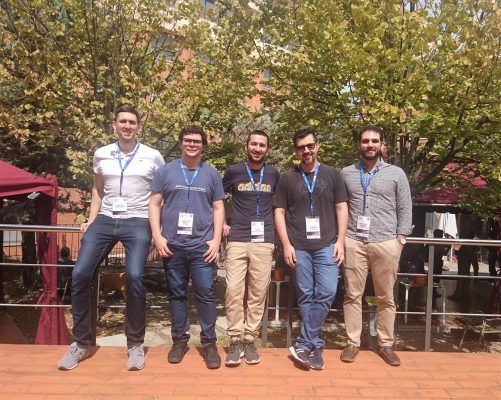
In 1962, Arthur C. Clark, a gifted man in fiction and non-fiction, said, “Any sufficiently advanced technology is indistinguishable from magic”. We are now in 2022 and, if we take Clarke’s premise, Barcelona Supercomputing Center – Centro Nacional de Supercomputación (BSC-CNS) is truly making magic.
The BCS-CNS hosted the ACM Summer School 2022. From 29 August to 2 September 2022, students, researchers, and professors from all over the world gathered to discuss High-Performance Computing (HPC), Artificial Intelligence (AI) and Machine Learning.
The RISC2 project supported the participation of Latin American students. We had the opportunity to travel from Argentina, Brazil, Chile, Colombia, and Costa Rica to connect with leading researchers in HPC at the ACM Summer School and boost our professional careers. For some of us, it was our first time in Europe. For others, it was the first time we had the chance to visit a research centre that hosts a TOP500 supercomputer such as Mare Nostrum. We shared our latent curiosity to learn, meet, and relate to people from all over the world.
We were welcomed to the ACM School by a legend in the world of HPC, Professor Mateo Valero, director of the BSC. World-class lecturers and researchers introduced us to topics that we had only read about in scientific articles, like specialized processors for machine learning, neuromorphic engineering, technical software development for new architectures, and vector accelerators. We could delve into the state-of-the-art of many lines of study, opening our minds in countless ways. We faced new challenges and found new perspectives that would allow us to advance our research projects and complete our graduate degrees.
Throughout the week, we met colleagues from all over the world with different lines of research, projects, and fields of study. This opportunity allowed us to create new relationships, nurtured us at a cultural level, and built new ties of friendship and possible professional contributions in the future, connecting Europe with Latin America. Likewise, we strengthened relations between Latin Americans, usually separated despite being neighbours. Conversations that initially arose with academic topics ended with more trivial issues, all accompanied by a cup of coffee or even a mate brought directly from Argentina. These conversations go hand in hand with great minds and unique people.
Professors like Valerie Taylor from the Argonne National Laboratory, Charlotte Frenkel from the Delft University of Technology, Luca Benini from the Università di Bologna and ETHZ, and Jordi Torres from Universitat Politècnica de Catalunya, among many others, allowed us to be part of a world that, in many cases, is hard to reach for many students in Latin America. Thanks to the RISC2 project, we had the opportunity to be part of this process, learn and bring back to our countries the knowledge about state of the art in HPC architectural trends and a new vision of the world of computing.
At the end of an intense week of study and conversations, of new knowledge and new friends, we returned to our countries of origin. Together, we have brought a new vision of the world of computing, new contacts, and many new perspectives that we can apply in our studies and share with our colleagues in the research groups and, perhaps, start new foci of study.
Finally, we hope to return and meet again, make new friends, share the knowledge acquired and our experiences, and further deepen the ties within Latin America and between Europe and Latin America. We hope that other fellow Latin Americans will also benefit from similar opportunities and that they can live these kinds of experiences. The RISC2 project gave us a unique opportunity, so we want to thank them and all of those who made it possible.
By:
- Claudio Aracena, University of Chile
- Christian Asch, CeNAT, Costa Rica
- Luis Alejandro Torres Niño, UIS, Colombia
- Matías Mazzanti, UBA, Argentina
- Matheus Borges Seidel, UFRJ, Brazil